What Is Sucralose (E955) In Food? Uses, Safety, Side Effects
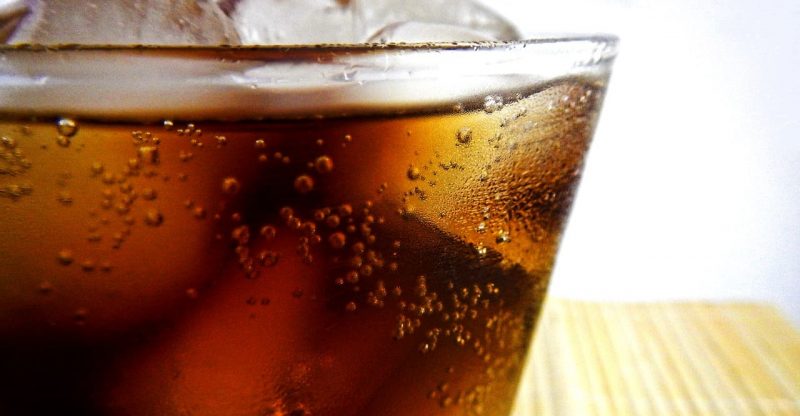
3 Types | Production | Health benefits | Uses | Safety | Side Effects | FAQs | Conclusion
Sucralose, a widely used sugar substitute, 600 times sweet than sugar, is a new generation of artificial sweetener developed after aspartame (E951) and acesulfame potassium (E950). It is free of carbs & calories and the European food additive number E955. Generally, it is safe, synthetic, vegan, halal, kosher and gluten-free.
Three types of Sucralose in the market
It is sold in raw material (in bulk) as pure powder and granular OR as finished products in the supermarket that can be directly (conveniently) used available as solid (such as Splenda) or liquid.
1. Pure sucralose
It is available in powder and granular form. China is the biggest manufacturer and exporter in the world, the export quantity in 2019 to United Status is around 2,000MT.
2. Splenda
Splenda is a common brand of the finished product of sucralose in the market and there are several types under this brand. Its no-calorie packet contains small amounts of the two carbs/bulking agents: dextrose and maltodextrin (1).
3. Liquid sucralose
It is a clear and colorless liquid and commonly sold in the market made of 25% of sucralose or with other concentrations, may contain very little composition of preservatives (such as potassium sorbate, sodium benzoate), acidulants (e.g. citric acid, succinic acid) and other components.
The liquid form is more stable and can extend the shelf life compared with the pure form.
It is recommended to use in PH level below 7 in general food, and PH below 8 in the bakery.
How is Sucralose Made?
Sucralose is a sugar derivation commercially produced by substituting three hydroxyl groups with three atoms of chlorine on the sugar molecule.
There are several synthesis ways and the following is the common manufacturing processes with three production steps, from the manufacturer – JK Sucralose Inc (2):
- Esterification process: reacting sucrose with acetic acid in the presence of diethyl azodicarboxylate to produce Sucrose-6-Acetate.
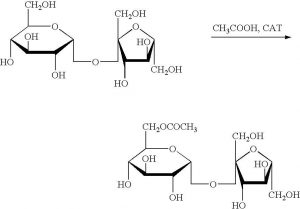
- Chlorination process: sucrose-6-Acetate reacts with the chlorinating agent, such as phosphorous pentachloride in DMF.
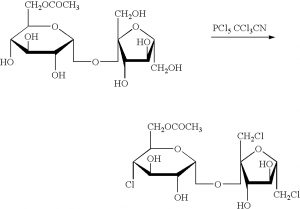
- Deacetylation: deacetylation of the product obtained in step 2 in a methanol solution with KOH as catalyst.
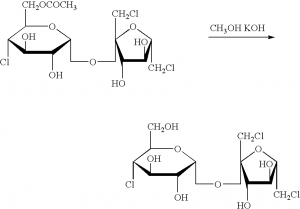
What are the Health Benefits of Sucralose?
Although it is made from sugar, it is not a sugar and cannot be utilized by our body to generate energy.
Sucralose is a functional sweetener that lowers sugar and calories in food when it is used in food to replace sugar or part of it.
The following are the three main health benefits:
- No calorie
- Zero glycemic index
- Tooth friendly
Zero Calorie
Sucralose is a non-nutritive sweetener that does not have calories and not considered as a carbohydrate and almost not metabolized and absorbed in the human body (3).
Zero Glycemic Index
It will not raise blood sugar so it has a glycemic index with 0 (4).
It will not affect insulin response and therefore can be used by diabetics. It is also suitable to be consumed by people with obesity and cardiovascular disease.
However, sucralose is only used to replace part of the sugar amount in some food products, so people with diabetes should watch out for the ingredient list whether it is totally sugar-free.
Tooth Friendly
It is listed as an eligible noncariogenic carbohydrate sweetener by the FDA (5), so it does not promote tooth decay & bring any calories and is suitable to add in kids’ food, such as in flavored milk, yogurt, puddings, juices and candies.
Specification
Other Names
- 4,1’,6’-Trichlorogalactosucrose
- 1,6-Dichloro-1,6-dideoxy-β-D-fructofuranosyl-4-chloro-4-deoxy-α-D-galactopyranoside
CAS Number
56038-13-2
Chemical Formula
C12H19Cl3O8
Molecular Weight
397.64
Properties
Appearance
White to off-white, crystalline powder or granular. Stable to light, heat and pH.
Sweetness
It has a clean sweet similar to sucrose, without the bitter aftertaste of some other no-calorie sweeteners, such as saccharin and acesulfame K.
Its 3% solution is approximately 600 times than table sugar, 3 times sweet than aspartame and acesulfame k, and 2 times sweet as sodium saccharin (E954).
Solubility
Freely soluble in water, methanol and ethanol; slightly soluble in ethyl acetate.
Structure

Image Source
What are the Uses of Sucralose?
Sucralose is commonly used in reduced sugar/calorie food without compromising on taste, e.g. soft drinks, powdered drink mixes, table top sweeteners, baking, yogurts, ice cream, and pharmaceutical tablets.
Beverage
Sucralose is mostly used in beverages, such as carbonated beverages, fruit juice, plant-based protein beverages, energy drink, coffee beverages, and alcoholic beverages.
Generally, the amount of sucrose added to beverages is usually between 8% and 10%. To reach the same sweetness, only 0.013% to 0.016% of sucralose is needed. That’s to say, for production 1000 kg beverage, 130 to 160g sucralose is enough.
Coca-Cola
Sucralose is used in carbonated drinks for its purpose of providing good sweet taste while bringing zero calories. We can find this ingredient in the label of DASANI Flavors, Diet Coke with SPLENDA®, and POWERADE Zero of Coca-Cola’s products (6). It is not used in Coke Zero, which is sweetened with the combination of aspartame and acesulfame potassium. (7)
Pepsico
Sucralose is used widely in Pepsi beverage, and you can find it in Diet Pepsi, Pepsi Zero Sugar, Protein Shake, Whey Protein Powder and so on. (8)
Redbull
Also, sucralose functions as a sugar substitute in the energy drink, such as in Redbull (9) . In sports nutrition supplements, it masks the bitterness produced by vitamins and other functional ingredients.
Other beverages
Sucralose can go through 120 °C sterilization in the production of soy milk and can mask the beany smell and make soy milk taste better. Sucralose is also suitable for alcoholic beverages. For example in fruit wine, little of it (or combination with sucrose) can improve the taste of wine products, mask the acidity of some wine products, and make them taste sweet, mellow, and no odor.
Baking
Unlike aspartame, sucralose is heat stable and can be used in cooking and baking.
Candy
Compared with traditional candy sweetened with sugar, sugar fee candy provides few carbs & calories, and suitable for diabetics. Artificial sweeteners (aspartame, acek and sucralose) and sugar alcohols (erythritol, maltitol, sorbitol) are often used for this purpose.
Coffee
Sucralose can lower the sugar amount in coffee products, therefore, decrease the energy intake. It can be used alone or in combination with other sweeteners such as sucrose, fructose and high-fructose corn syrup. Many well-known international companies have coffee products containing sucralose, such as Nestle, and Kraft.
The application of aspartame in coffee is decreasing. Acesulfame K is also used in coffee but always blended with other sweeteners for a better taste.
Other high-intensity sweeteners, such as stevia, cyclamate, sodium saccharin are used less in this field.
Yogurt
As a milk fermentation product, yogurt not only has the nutrition of milk, but also increases the fatty acid content of dairy products during the fermentation process, which makes yogurt easier to digest and absorb in our human body.
In addition, the lactic acid bacteria used in yogurt fermentation can also produce a variety of vitamins required for human nutrition.
However, most traditional yogurts are sweetened with sucrose and a total of 6% to 10% sucrose has to be added during yogurt production. That’s known to all that eating too many high-sugar products will cause diseases such as obesity, coronary arteriosclerosis, and is a risk to people with diabetes, which is inconsistent with the health effects of yogurt.
Using sucralose to replace sucrose and other sweeteners can effectively improve the taste of yogurt, making it more sweet and attractive.
The successful application of sucralose in the production of beverages and candy has aroused the attention of yogurt manufacturers to use it in low sugar and low energy yogurt, for the advantages of its pure and high sweetness (600 times that of sucrose), no energy, no insulin response, and high safety.
In the production of yogurt, sucralose cannot be utilized by lactic acid bacteria & yeast and can be used in combination with sucrose to reduce the amount of sucrose, which not only reduces the energy, the cost for manufacturers, but also avoids more sucrose metabolized by lactic acid bacteria and yeast that brings uncomfortable taste to the yogurt.
Therefore, it improves the taste and neutralizes the acidity of yogurt products.
Protein Powder
If you take a look at the ingredient list of your protein powder (e.g. whey protein and protein shake), you may find sucralose in it. As you may know, most protein powders are hard to eat if without adding sweetener or/and flavor. Sucralose is used to mask the bitterness naturally derived from the plant and impart a sweet state to your protein powder with free calories for your bodybuilding.
Others
In personal care products, it may also be used as a sweetener to replace sugar such as in toothpaste and mouthwash, as sucralose will not cause tooth cavities. In pharmaceuticals, it can be used as an excipient in syrups, lozenges and chewable tablets to mask the bitterness.
Is Sucralose Safe to Eat?
Yes, it has been approved safe by U.S. Food and Drug Administration (FDA), European Food Safety Authority (EFSA), as well as Joint FAO/WHO Expert Committee on Food Additives (JECFA). It is being used in over 80 countries and in 4000 products+ worldwide (10).
FDA
May be used as a sweetener in foods generally permitted for direct addition to food for human consumption. (11)
EFSA
Sucralose (E955) is listed in Commission Regulation (EU) No 231/2012 as an authorised food additive and categorized as “sweeteners” .(12)
Authorised Uses And Use Levels
It is approved to use in a lot of energy-reduced or no sugar applications, some of the lists as follows: (13):
- Flavoured fermented milk products
- Jams jellies and marmalades
- Flavoured drinks
- Confectionery
- Cocoa and chocolate products
- Chewing gum (added with/no sugars or polyols)
- Sauces
- Breakfast cereals
- Table-top sweeteners in liquid/powder/tablets form
- Alcoholic drinks
UK Food Standards Agency
Categorized in “Sweeteners” (14)
Food Standards Australia New Zealand
In Australia and New Zealand are all with the code number 955. (15)
JECFA
Functional Class: food additives, sweetener. (16)
Acceptable daily intake: ADI “15 mg/kg bw” set in 1990. (17)
Is Sucralose Bad for You?
Artificial sweeteners are the most controversial food additives although they have been approved safe by authorities. That’s why sucralose is generally considered safe but consumers always have health concerns whether it is bad for their health and what are the possible side effects.
The following are the most discussed potential adverse effects, especially cancer.
- Cancer
- Diarrhea
- Gut gas
- Chloride
- Weight gain
- Headaches
- Stomach pain
- Allergy
Let’s go through the most mentioned possible side effects one by one and figure it out with the help of authority resources.
Does Sucralose Cause Cancer?
No. Many studies have claimed that sucralose is non-carcinogenic but a well-known research in mice performed by the Ramazzini Institute and reported in 2016 found sucralose may increase the risk of hematopoietic tumors (leukemias) (18) and due to this finding CSPI downgraded this artificial sweetener from “Caution” to “Avoid” (19).
In this experiment, the intake of sucralose ranged from 0, 62.5, 250, 1,000 and 2,000 mg/kg bw, which was 12.5 to 400 times the established ADI – 5mg/kg bw by the FDA.
However, EFSA had the opposite opinion that the relationship between sucralose and cancer cannot be established as this research had significant scientific shortcomings, for example, the absence of an appropriate concurrent control group, and the lack of evidence between sucralose exposure and incidence of lymphomas and leukaemias. (20)
Does Sucralose Cause Diarrhea?
It is known that sugar alcohols will lead to laxative effects by the FDA. There were few studies reported that sucralose is linked with diarrhea but Columbia University said that sucralose and other artificial sweeteners may cause diarrhea and gas (21).
A study showed nonnutritive sweeteners have bacteriostatic effects and can change the intestinal microbiota. (22)
Does Sucralose Cause Gas?
No. It is claimed in Splenda blog that consumption of sucralose will not lead to gastrointestinal gas and bloating as it is not fermentable in gut during the digestive process. It should be attributed to other ingredients in food if gas and bloating do happens when a person eating food with sucralose. (23)
Will Sucralose Break a Fast?
Sucralose does not break a fast as it contains no calories and not affect blood sugar and insulin level in the body. “Fast” means not consuming any calories from food and drink.
Is the Chloride in Sucralose Safe?
Yes. Sucralose contains chlorine which makes it 600 times as sweet as sugar and cannot be digested by the body. Chlorine does not separate from sucralose after ingestion, nor does it accumulate in the body. Chlorine is naturally present in many foods and is a component of table salt.
Can Dogs and Cats Have the Food with Sucralose?
Yes, it is safe for dogs to eat food with sucralose. Different with xylitol, which is dangerous to dogs that causes a life-threatening decrease of blood sugar within 10 to 60 minutes after eating food with xylitol (24).
Does Sucralose Cause Weight Gain?
It’s surprising that sucralose was associated with increase of weight and obesity instead of the opposite, which was reported in Canadian Medical Association Journal in 2017 after 30 studies last 10 years and 7 studies for 6 month on 406,910 people (25).
However, as Time suggested, this study was not persuasive as that people who consume more artificial sweeteners may eat more processed food that leads to a higher risk of obesity. (26)
Is Sucralose Safe during Pregnancy?
Yes, it is safe for women who are pregnant or breastfeeding concluded from animal and human feeding studies (27). A study in 20 lactating women in 2015 found sucralose were present in breast milk from 13 women (as it almost not be metabolized) which was intaked from sweetener packets, diet soda or other sources. (28)
Does Sucralose Cause Headaches?
Sucralose is not linked to headaches. But a woman with menstrually related migraine, was found the migraine was consistently triggered by sucralose, which was reported in 2006. (29)
Does Sucralose Upset Stomach Pain?
No such authority information was reported so far.
Does Sucralose Cause allergies?
No. In 2013, a doctor asked American Academy of Allergy, Asthma & Immunology (AAAAI) for help regarding to the allergy studies of artificial sweeteners as his/her two patients complained of allergy symptoms (oral pruritis, lip angioedema and other reactions) caused by artificial sweeteners (ie: stevia and sucralose).
However, AAAAI responded that there is a report of allergy to stevia but none to sucralose.
Stevia is extracted from a plant and IgE can be synthesized to this ingredient, while, sucralose is made from sugar by substitution three hydroxyl groups with three chlorine atoms, so an IgE-mediated reaction to it would be rare. (30)
Frequently asked questions
Is Sucralose Keto?
Yes, a ketogenic diet means we intake daily calories mostly (90%) from fat (31), moderate from protein and less from carbohydrate. Keto diet is used to treat epilepsy in medical application, but more and more used for weight loss. Sucralose does affect ketosis as it is not a carbohydrate and calorie free.
Is Sucralose natural?
No, Although it has similar structure with sugar and made from sugar, it is not natural.
Is Sucralose Halal?
Yes, it is generally recognised as halal as it is permitted under the Islamic Law and fulfill the conditions of Halal. And we can find some manufacturers certificated with MUI halal.
Is Sucralose Kosher?
Yes, it is kosher pareve. E955 meets all the “kashruth” requirements and can be certified as kosher or maybe passover.
Is Sucralose Vegan?
Yes, it is vegan as derived from sugar and the manufacturing process does not use any ingredients that come from animals. So it is suitable to add in the diet of vegetarians.
Is Sucralose gluten free?
Yes, it is gluten free as complies with the FDA’s definition of gluten free, that it does not contain wheat, rye, barley, or crossbreeds of these grains. And it is generally considered safe for people with celiac disease.
Sucralose vs Aspartame?
Both are artificial sweeteners but different. The following are the major nine difference between them:
- Taste: each taste is unique but the taste of aspartame is more close to table sugar.
- Sweetness: sucralose is three times sweet than aspartame.
- Price: similar to the sweetness.
- Metabolism: aspartame will be digested and metabolized whereas sucralose not.
- Calorie: sucralose is a nonnutritive high-intensity sweetener without calorie while aspartame is a nutritive sweetener and contains more than 2% the calories of table sugar.
- Uses: the heat stability enables sucralose to be used in baking and cooking while aspartame will be decomposed below 100℃ and therefore cannot be applied in theses applications.
- Acceptable Daily Intake (ADI): aspartame has a higher ADI with the number 50 mg/kg bw/d compared with sucralose, the value of which is 5 mg/kg bw/d by the FDA. (32)
- Safety: both are approved safe but aspartame breaks down to phenylalanine after digestion, which is dangerous to people with phenylketonuria (PKU).
- Manufacturing: sucralose is derived from sugar, aspartame is made of two amino acids ( phenylalanine and aspartic acid) and methanol.
Conclusion
Now I think you may have a good knowledge of the artificial sweetener – sucralose (E955), from three types, production process, three main health benefits, uses, approved safety and possible side effects. Also, you may be clear with some common FAQs such as is it gluten free, vegan, and its comparison with aspartame.
What kinds of food packaging have you found this additive in? Let me know in the comments.

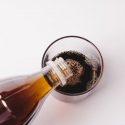
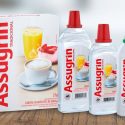
halal food are only made by Muslims and they do some rituals when doing halal read kalma and spit on product, are you sure sweetener 955 is halal?
This is a main ingredient in 7 Eleven Sugar Free Slurpees in Australia.